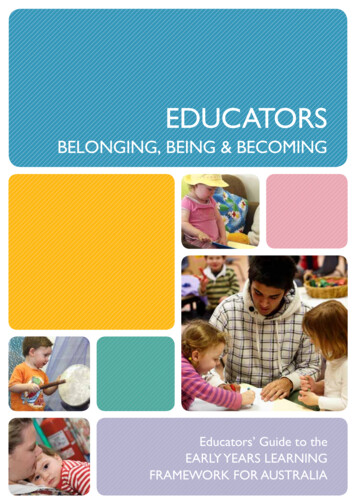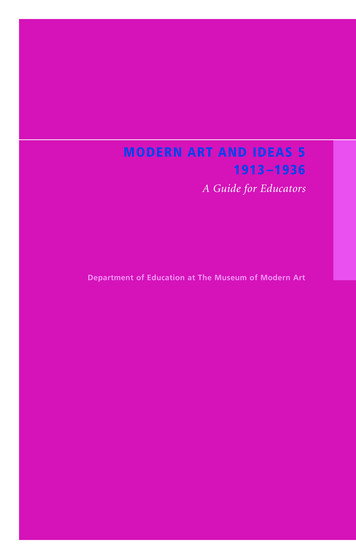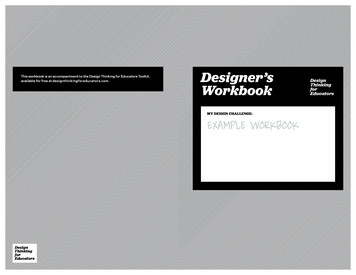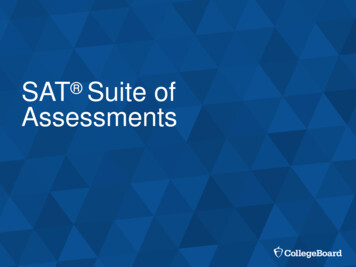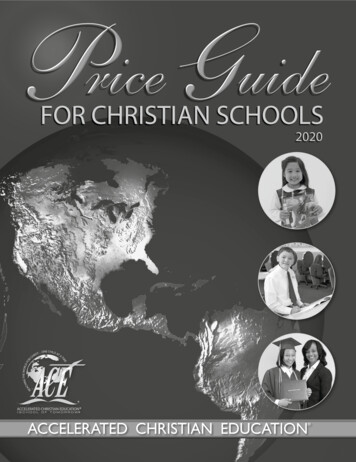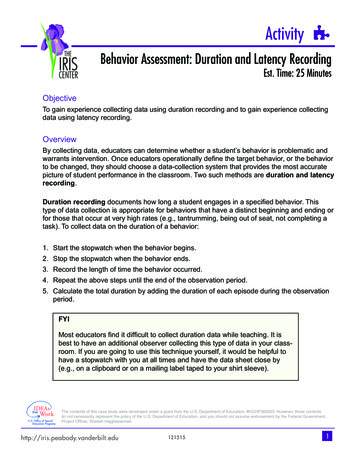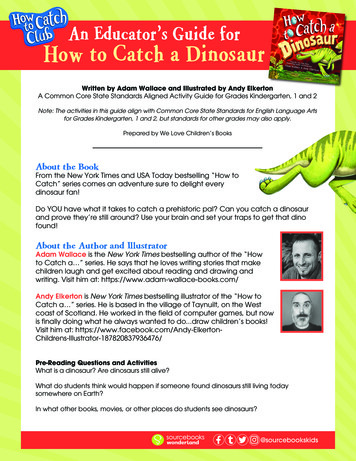
Transcription
An EducatorÕs Guide forHow to Catch a DinosaurWritten by Adam Wallace and Illustrated by Andy ElkertonA Common Core State Standards Aligned Activity Guide for Grades Kindergarten, 1 and 2Note: The activities in this guide align with Common Core State Standards for English Language Artsfor Grades Kindergarten, 1 and 2, but standards for other grades may also apply.Prepared by We Love Children’s BooksAbout the BookFrom the New York Times and USA Today bestselling “How toCatch” series comes an adventure sure to delight everydinosaur fan!Do YOU have what it takes to catch a prehistoric pal? Can you catch a dinosaurand prove they’re still around? Use your brain and set your traps to get that dinofound!About the Author and IllustratorAdam Wallace is the New York Times bestselling author of the “Howto Catch a ” series. He says that he loves writing stories that makechildren laugh and get excited about reading and drawing andwriting. Visit him at: https://www.adam-wallace-books.com/Andy Elkerton is New York Times bestselling illustrator of the “How toCatch a ” series. He is based in the village of Taynuilt, on the Westcoast of Scotland. He worked in the field of computer games, but nowis finally doing what he always wanted to do.draw children’s books!Visit him at: lustrator-187820837936476/Pre-Reading Questions and ActivitiesWhat is a dinosaur? Are dinosaurs still alive?What do students think would happen if someone found dinosaurs still living todaysomewhere on Earth?In what other books, movies, or other places do students see dinosaurs?@sourcebookskids
An EducatorÕs Guide forHow to Catch a DinosaurVocabularyWhile you read the book aloud to the class, have students identify unfamiliar words andcreate a vocabulary list to go along with the book. Define the words as a class using anarray of strategies to determine meaning, including context, accompanying illustrations inthe story and the dictionary if needed. Provide real-life connections to these new words bydiscussing other situations where they could be used. Have students practice using thesenew words in a sentence. Can students think of other words that could be used that havesimilar meanings?RL K.4L K.4, K.5, 1.4, 1.5, 2.4, 2.5Post-Reading Questions and ActivitiesWhy?Come together as a class and review the story. Why do the kids want to catch thedinosaur? What do they hope to do with the dinosaur when they trap it? Do things work outthe way the kids had hoped with the dinosaur? How do they end up winning the ScienceFair prize? How do the boy’s friends and family help him?RL K.1, K.3, K.7, 1.1, 1.3, 1.7, 2.1, 2.3, 2.7SL K.1, K.2, 1.1, 1.2, 2.1, 2.2Turning Traps into Science Fair ProjectsBreak students into small groups and assign each group a two-page spread from the bookfor closer study. In this book, the children set traps for the dinosaur, but she is never caught.By the end of the story, each trap has served as the basis for a science fair project. Haveeach group present their trap, what it was supposed to do, and what science fair project itturned into.RL K.1, K.3, K.7, 1.1, 1.3, 1.7, 2.1, 2.3, 2.7SL K.1, K.4, K.5, 1.1, 1.4, 1.5, 2.1, 2.4, 2.5How to Catch a Dinosaur: Classroom EditionHave students design and draw their own traps for the dinosaur. What will the trap do?Working with an adult, have students write rhyming text about the trap and the escape, asin the book. Have volunteers share their creations with the class. Insert the new traps intothe book to create a supersized classroom edition of How to Catch a Dinosaur.K.3, 1.3, 2.3SL K.5, 1.5, 2.5Compare and ContrastOne of the fun things about the “How to Catch ” series is that each book is a littledifferent. The kids have different reasons for wanting to catch each creature and eachcreature has its own reason for not wanting to be caught. Compare this book to anotherin the series, for example How to Catch a Yeti. In these stories, the children are driven by adesire to prove that the creature they are chasing really exists. When comparing the stories,consider the following questions:@sourcebookskids
An EducatorÕs Guide forHow to Catch a Dinosaur Who are the characters? Who is telling the story? Where and when do the stories take place? What are the main conflicts and how do they get resolved? What are the big ideas or themes of these stories?RL K.1, K.2, K.3, K.7, K.9, 1.1, 1.2, 1.3, 1.7, 1.9, 2.1, 2.2, 2.3, 2.5, 2.7SL K.1, K.2, 1.1, 1.2, 2.1, 2.2Expressive LettersIn picture books, the words and the illustrations combine to tell the story. But in this book,some words become illustrations themselves! Review the book as a class to find the fancy,illustrated words. How does the appearance of the word relate to its meaning and help tellthe story? Have each student select a different word from the book and draw that word ina stylized way that highlights its meaning. Have volunteers share their word with the classand read it aloud in an expressive manner befitting the style and meaning of the word.RL K.1, K.7, 1.1, 1.7, 2.1, 2.7SL K.1, K.4, K.5, 1.1, 1.4, 1.5, 2.1, 2.4, 2.5Dino-BirdsThis book contains some real information about dinosaurs. When the dinosaur avoids thecage with birdseed in it, one child is holding a feather. How does that “clue” tie into thetext on the page? What real scientific information about dinosaurs does this book tellthe reader? Using the internet and library resources, do a class research project on therelationship between dinosaurs and birds.RL K.1, K.7, 1.1, 1.3, 1.7, 2.1, 2.7W K.7, K.8, 1.7, 1.8, 2.7, 2.8Turning Science Experiments into TrapsThe traps in this book are more than just nets and ropes. These traps are inspired by classicscience fair projects. Using predetermined experiments, or books and the internet, breakstudents into groups and have each one research a science experiment they want toperform, and come up with a plan to use it as a trap. Working with an adult, have eachgroup perform their experiment for the rest of the class and explain how they would use itto trap a dinosaur!W K.7, 1.7, 2.7SL K.1, K.4, K.5, 1.1, 1.4, 1.5, 2.1, 2.4, 2.5Visit the Common Core State Standards website to read about the individual standardslisted in this guide: ookskids
An EducatorÕs Guide forHow to Catch a DinosaurFor ReferenceCommon Core State Standards UsedReading Standards for Literature KINDERGARTEN (RL)Key Ideas and DetailsK.1. With prompting and support, ask and answer questions about key details in a text.K.3. With prompting and support, identify characters, settings and major events in a story.Craft and StructureK.4. Ask and answer questions about unknown words in a text.K.6. With prompting and support, name the author and illustrator of a story and define therole of each in telling the storyIntegration of Knowledge and IdeasK.7. With prompting and support, describe the relationship between illustrations and thestory in which they appear (e.g., what moment in a story an illustration depicts).K.9. With prompting and support, compare and contrast the adventures and experiencesof characters in familiar storiesWriting Standards KINDERGARTEN (W)Text Types and PurposesK.3. Use a combination of drawing, dictating, and writing to narrate a single event orseveral loosely linked events, tell about the events in the order in which they occurred,and provide a reaction to what happened.Research to Build and Present KnowledgeK.7. Participate in shared research and writing projects (e.g., explore a number of books bya favorite author and express opinions about them).K.8. With guidance and support from adults, recall information from experiences or gatherinformation from provided sources to answer a question.Speaking and Listening Standards KINDERGARTEN (SL)Comprehension and CollaborationK.1. Participate in collaborative conversations with diverse partners about kindergartentopics and texts with peers and adults in small and larger groups.a. Follow agreed-upon rules for discussions (e.g., listening to others and taking turnsspeaking about the topics and texts under discussion).b. Continue a conversation through multiple exchangesK.2. Confirm understanding of a text read aloud or information presented orally orthrough other media by asking and answering questions about key details andrequesting clarification if something is not understood.@sourcebookskids
An EducatorÕs Guide forHow to Catch a DinosaurPresentation of Knowledge and IdeasK.4. Describe familiar people, places, things and events and, with prompting and support,provide additional detail.K.5. Add drawings or other visual displays to descriptions as desired to provide additionaldetail.Language Standards KINDERGARTEN (L)Vocabulary Acquisition and UseK.4. Determine or clarify the meaning of unknown and multiple-meaning words and phrasesbased on kindergarten reading and content.a. Identify new meanings for familiar words and apply them accurately (e.g., knowingduck is a bird and learning the verb to duck).b. Use the most frequently occurring inflections and affixes (e.g., -ed, -s, re-, un-, pre-,-ful, -less) as a clue to the meaning of an unknown word.K.5. With guidance and support from adults, explore word relationships and nuances inword meanings.a. Sort common objects into categories (e.g., shapes, foods) to gain a sense of theconcepts the categories represent.b. Demonstrate understanding of frequently occurring verbs and adjectives by relatingthem to their opposites (antonyms).c. Identify real-life connections between words and their use (e.g., note places atschool that are colorful).d. Distinguish shades of meaning among verbs describing the same general action(e.g., walk, march, strut, prance) by acting out the meaningsReading Standards for Literature Grade 1 (RL)Key Ideas and Details1.1. Ask and answer questions about key details in a text.1.2. Retell stories, including key details, and demonstrate understanding of their centralmessage or lesson.1.3. Describe characters, settings, and major events in a story, using key details.Integration of Knowledge and Ideas1.7. Use illustrations and details in a story to describe its characters, setting, or events.1.9. Compare and contrast the adventures and experiences of characters in stories.Writing Standards Grade 1 (W)Text Types and Purposes1.3. Write narratives in which they recount two or more appropriately sequenced events,include some details regarding what happened, use temporal words to signal eventorder, and provide some sense of closure.@sourcebookskids
An EducatorÕs Guide forHow to Catch a DinosaurResearch to Build and Present Knowledge1.7. Participate in shared research and writing projects (e.g., explore a number of “how-to”books on a given topic and use them to write a sequence of instructions).1.8. With guidance and support from adults, recall information from experiences or gatherinformation from provided sources to answer a question.Speaking and Listening Standards Grade 1 (SL)Comprehension and Collaboration1.1. Participate in collaborative conversations with diverse partners about grade 1 topicsand texts with peers and adults in small and larger groups.a. Follow agreed-upon rules for discussions (e.g., listening to others with care, speakingone at a time about the topics and texts under discussion).b. Build on others’ talk in conversations by responding to the comments of othersthrough multiple exchanges.c. Ask questions to clear up any confusion about the topics and texts under discussion.1.2. Ask and answer questions about key details in a text read aloud or informationpresented orally or through other media.1.3. Ask and answer questions about what a speaker says in order to gather additionalinformation or clarify something that is not understood.Presentation of Knowledge and Ideas1.4. Describe people, places, things, and events with relevant details, expressing ideas andfeelings clearly.1.5. Add drawings or other visual displays to descriptions when appropriate to clarify ideas,thoughts, and feelings.Language Standards Grade 1 (L)Vocabulary Acquisition and Use1.4. Determine or clarify the meaning of unknown and multiple-meaning words and phrasesbased on grade 1 reading and content, choosing flexibly from an array of strategies.a. Use sentence-level context as a clue to the meaning of a word or phrase.b. Use frequently occurring affixes as a clue to the meaning of a word.c. Identify frequently occurring root words (e.g., look) and their inflectional forms (e.g.,looks, looked, looking).1.5. With guidance and support from adults, demonstrate understanding of wordrelationships and nuances in word meanings.a. Sort words into categories (e.g., colors, clothing) to gain a sense of the concepts thecategories represent.b. Define words by category and by one or more key attributes (e.g., a duck is a birdthat swims; a tiger is a large cat with stripes).c. Identify real-life connections between words and their use (e.g., note places athome that are cozy).d. Distinguish shades of meaning among verbs differing in manner (e.g., look, peek,@sourcebookskids
An EducatorÕs Guide forHow to Catch a Dinosaurglance, stare, glare, scowl) and adjectives differing in intensity (e.g., large, gigantic)by defining or choosing them or by acting out the meanings.Reading Standards for Literature Grade 2 (RL)Key Ideas and Details2.1. Ask and answer such questions as who, what, where, when, why, and how todemonstrate understanding of key details in a text.2.2. Recount stories, including fables and folktales from diverse cultures, and determine theircentral message, lesson, or moral.2.3. Describe how characters in a story respond to major events and challenges.Craft and Structure2.5. Describe the overall structure of a story, including describing how the beginningintroduces the story and the ending concludes the action.Integration of Knowledge and Ideas2.7. Use information gained from the illustrations and words in a print or digital text todemonstrate understanding of its characters, setting, or plot.Writing Standards Grade 2 (W)Text Types and Purposes2.3. Write narratives in which they recount a well-elaborated event or short sequence ofevents; include details to describe actions, thoughts, and feelings; use temporal wordsto signal event order; and provide a sense of closure.Research to Build and Present Knowledge2.7. Participate in shared research and writing projects (e.g., read a number of books on asingle topic to produce a report; record science observations).2.8. Recall information from experiences or gather information from provided sources toanswer a question.Speaking and Listening Standards Grade 2 (SL)Comprehension and Collaboration2.1. Participate in collaborative conversations with diverse partners about grade 2 topicsand texts with peers and adults in small and larger groups.a. Follow agreed-upon rules for discussions (e.g., gaining the floor in respectful ways,listening to others with care, speaking one at a time about the topics and textsunder discussion).b. Build on others’ talk in conversations by linking their comments to the remarks ofothers.c. Ask for clarification and further explanation as needed about the topics and textsunder discussion.2.2. Recount or describe key ideas or details from a text read aloud or informationpresented orally or through other media@sourcebookskids
An EducatorÕs Guide forHow to Catch a Dinosaur2.3. Ask and answer questions about what a speaker says in order to clarify comprehension,gather additional information or deepen understanding of a topic or issue.Presentation of Knowledge and Ideas2.4. Tell a story or recount an experience with appropriate facts and relevant, descriptivedetails, speaking audibly in coherent sentences.2.5. Create audio recordings of stories or poems; add drawings or other visual displays tostories or recounts of experiences when appropriate to clarify ideas, thoughts, andfeelings.Language Standards Grade 2 (L)Vocabulary Acquisition and Use2.4. Determine or clarify the meaning of unknown and multiple-meaning words and phrasesbased on grade 2 reading and content, choosing flexibly from an array of strategies.a. Use sentence-level context as a clue to the meaning of a word or phrase.b. Determine the meaning of the new word formed when a known prefix is added to aknown word (e.g., happy/unhappy, tell/retell).c. Use a known root word as a clue to the meaning of an unknown word with the sameroot (e.g., addition, additional).d. Use knowledge of the meaning of individual words to predict the meaning ofcompound words (e.g., birdhouse, lighthouse, housefly; bookshelf, notebook,bookmark).e. Use glossaries and beginning dictionaries, both print and digital, to determine orclarify the meaning of words and phrases.2.5. Demonstrate understanding of word relationships and nuances in word meanings.a. Identify real-life connections between words and their use (e.g., describe foods thatare spicy or juicy).b. Distinguish shades of meaning among closely related verbs (e.g., toss, throw, hurl)and closely related adjectives (e.g., thin, slender, skinny, scrawny).@sourcebookskids
Visit the Catch Club online athowtocatchclub.com for: A sign-up for the exclusive Catch Club emailnewsletter for downloadable activities andsneakpeeks at new How to Catch books Downloadable crafts and recipes Videos from Adam Wallace Games and contests And more!@sourcebookskids
the book to create a supersized classroom edition of How to Catch a Dinosaur. K.3, 1.3, 2.3 SL K.5, 1.5, 2.5 Compare and Contrast One of the fun things about the “How to Catch ” series is that each book is a little different. The kids have different reasons for



